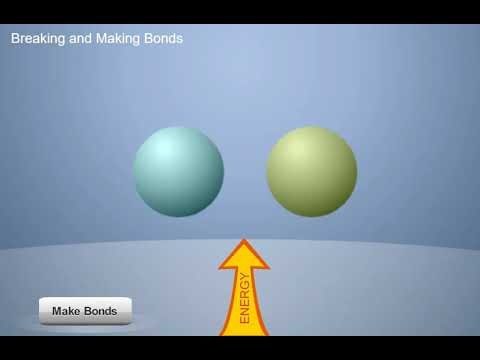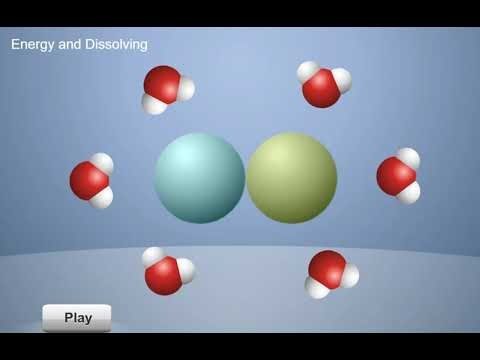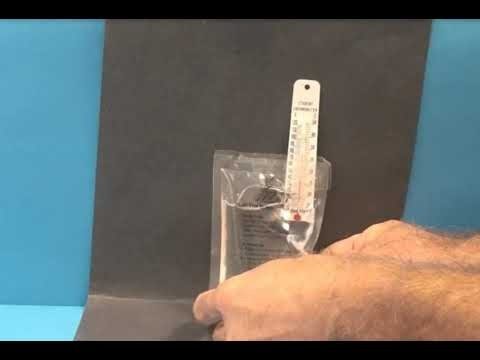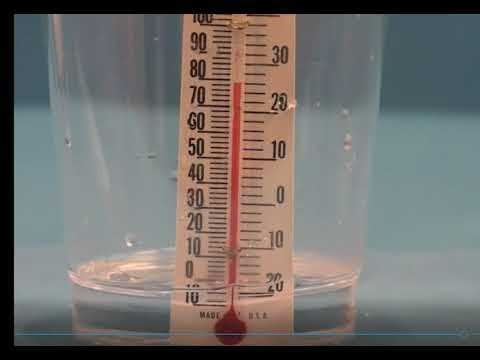Temperature Changes in Dissolving
Lesson Summary Video for teachers
Note: This video is designed to help the teacher better understand the lesson and is NOT intended to be shown to students. It includes observations and conclusions that students are meant to make on their own.
Key Concepts
- The process of dissolving can be endothermic (temperature goes down) or exothermic (temperature goes up).
- When water dissolves a substance, the water molecules attract and “bond” to the particles (molecules or ions) of the substance causing the particles to separate from each other.
- The “bond” that a water molecule makes is not a covalent or ionic bond. It is a strong attraction caused by water’s polarity.
- It takes energy to break the bonds between the molecules or ions of the solute.
- Energy is released when water molecules bond the solute molecules or ions.
- If it takes more energy to separate the particles of the solute than is released when the water molecules bond to the particles, then the temperature goes down (endothermic).
- If it takes less energy to separate the particles of the solute than is released when the water molecules bond to the particles, then the temperature goes up (exothermic).
Summary
Students will feel the temperature change that occurs when a cold pack and a hot pack are activated. They will see that these temperature changes are due to a solid substance dissolving in water. Students will then compare the temperature changes that occur as four different solutes dissolve in water and classify these as either endothermic or exothermic. Students will be introduced to the concept that it takes energy to break bonds and energy is released when bonds are formed during the process of dissolving.
Objective
Students will be able to identify variables in an experiment to find out how much the temperature increases or decreases as each of four solutes dissolves in water. Students will be able to correctly classify the process of dissolving as either exothermic or endothermic for each solute. Students will be able to explain that the temperature changes in dissolving are a result of the amount of energy released compared to the amount of energy used as “bonds” are formed and broken.

Safety
Be sure you and the students wear properly fitting goggles. Excess dry material from the hot and cold packs can be placed in the trash. Sodium carbonate may be a skin irritant. Have students wash hands after the activity.
Materials for the Demonstrations
- 2 disposable cold packs
- 2 disposable hot packs
- Graduated cylinder
- Water (room temperature)
- 2 clear plastic cups
- 2 thermometers
Materials for Each Group
- Potassium chloride
- Calcium chloride
- Sodium carbonate
- Sodium bicarbonate
- Water
- 5 small cups
- Graduated cylinder
- Thermometer
- Gram balance
Notes about the Materials
- The cold pack used in this lesson contains urea. The hot pack contains magnesium sulfate. Both types of packs contain a water-filled bag along with the urea or magnesium sulfate powder inside the outer bag. Both types of packs can be purchased on www.amazon.com.
- The hand warmer shown in the video in the Extend contains a super-saturated solution of sodium acetate with a small metal disk inside a clear plastic bag. This warmer is activated by bending the metal disk slightly. These hand warmers, called “The Heat Solution”, are available from Flinn Scientific.
- Potassium chloride, calcium chloride (anhydrous), and sodium carbonate (anhydrous) can all be purchased from Flinn Scientific.
- Sodium bicarbonate is baking soda, available at the grocery store.
Note: This activity deals with a concept that is not often addressed in middle school—that a temperature change occurs during the process of dissolving. Most middle school textbooks and curricula associate a change in temperature only with chemical change. Dissolving is usually considered a physical change but also can result in a change in temperature. This change in temperature is based on the energy changes involved in breaking and making “bonds” in the process of dissolving.
Read more about the energy changes in making and breaking bonds in Teacher Background.
- Lesson 5.9 Teacher Background PDF
Download All Lesson 5.9 Resources
Get the entire lesson plan and Student Activity Sheet for " Lesson 5.9 - Temperature Changes in Dissolving."
Online Assignments
Supplement in-class learning with interactive, multimedia-rich Google Forms lesson modules, perfect for reinforcing key chemistry concepts and scientific investigation skills.
Instructions
1 Engage
Step 1
Allow students to feel the temperature change in an activated cold pack and an activated hot pack.
Tell students that they will explore how some hot and cold packs work. Give them a hint that it has to do with dissolving, which they have been studying in this chapter.
Materials for the Demonstration
- 1 disposable cold pack
- 1 disposable hot pack
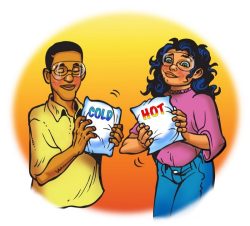
Procedure
- Select two student volunteers—one to activate one cold pack and another to activate one hot pack.
- Have each student feel each bag and guess what is inside each. They should notice a dry pellet-like solid and a fluid-filled bag. Point out that the bags do not feel cold or hot yet.
- Direct the students to activate their packs by following the instructions on the package. Have them shake the packs to get the fluid to spread throughout the bag.
- Pass the cold and hot packs around the room.
Expected Results
The cold pack quickly becomes cold while the hot pack quickly becomes hot.
Step 2
Do a demonstration to show how cold and hot packs work.
Note: In this demonstration, 1 teaspoon of each substance is dissolved in 10 mL of water. Since the purpose of this demonstration is to show whether the temperature simply goes up or down, this type of volume measure is fine. But to compare which substance is more or less exothermic or endothermic than another, as students will do in the activity, the solute will be measured in grams.
Materials for the Demonstration
- 1 disposable cold pack
- 1 disposable hot pack
- Graduated cylinder, 50 mL or smaller
- Water (room temperature)
- 2 clear plastic cups
- 2 thermometers
- 1 teaspoon
Procedure
- Carefully cut open one cold pack and one hot pack. Show students the contents, but do not handle or allow students to handle the solid substance inside the packs.
- Tell students that the liquid inside the fluid-filled bags in both the cold and hot packs is water. Pour about 10 mL of room temperature water in two separate clear plastic cups.
- Place a thermometer in each cup and select two student volunteers to tell the class the starting temperature of the water in each cup.
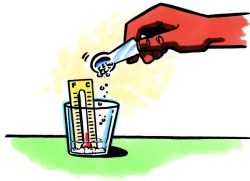
- With the thermometer still in the cup, add about 1 teaspoon of the solid substance from the cold pack to the water in one cup. Gently swirl the cup to help the substance dissolve. Have the class watch the thermometer and then ask a student to tell the class the lowest temperature of the solution.
- With the thermometer still in the cup, place about 1 teaspoon of the substance from the hot pack in the water in the other cup. Gently swirl the cup to help the substance dissolve. Have the class watch the thermometer and then ask a student to tell the class the highest temperature of the solution.
Expected Results
Dissolving the substance from the cold pack will cause the temperature to decrease to less than 10 °C (endothermic). Dissolving the substance from the hot pack will cause the temperature to increase to over 40 °C (exothermic). Results may vary.
Step 3
Introduce the terms endothermic and exothermic.
Tell students that scientists describe temperature changes that occur when substances interact as either endothermic or exothermic. When the temperature decreases, as it does in the cold pack, the process is endothermic. When the temperature increases, as it does in the hot pack, the process is exothermic.
2 Evaluate
Give each student an activity sheet.
- Lesson 5.9 Student Activity Sheet PDF | DOCX | Google Doc
- Lesson 5.9 Activity Sheet Answers PDF | DOCX | Google Doc
Download the student activity sheet, and distribute one per student.
The activity sheet will serve as the “Evaluate” component of each 5-E lesson plan. The activity sheets are formative assessments of student progress and understanding. A more formal summative assessment is included at the end of each chapter.
Students will record their observations and answer questions about the activity on the activity sheet. The Explain It with Atoms and Molecules and Take It Further sections of the activity sheet will either be completed as a class, in groups, or individually depending on your instructions. Look at the teacher version of the activity sheet to find the questions and answers.
3 Explore
Step 4
Introduce the dissolving activity students will do and help students identify the variables.
Tell students that they will compare how much the temperature changes when four household substances dissolve in water. Introduce the crystals students will dissolve:
- Potassium chloride is a common salt substitute.
- Calcium chloride is used to absorb moisture from the air. It is also included in some ice-melt mixtures to treat icy sidewalks during winter.
- Sodium carbonate is a common ingredient in detergents for dishwashing machines.
- Sodium bicarbonate, also known as baking soda, is used in baking, in toothpaste, and numerous other applications.
Ask students:
- How can we set up a fair comparison to find out which solute is the most endothermic and which is most exothermic when dissolved in water?
Be sure students know to use the same amount of each solute. Based on what they learned in Chapter 5, lesson 5, students should realize that each crystal should be weighed in grams. Students should also remember that they must use the same amount of water at the same temperature. Tell students that in this activity, they will need to swirl the solutes in the water to help them dissolve faster. They should be careful to swirl each cup in the same way for each test.
Note: Comparing the amount of temperature change for different substances by dissolving the same mass of each substance in the same amount of water is fine at the middle school level. However, a more rigorous approach is to dissolve the same number of particles (molecules or ionic units) of each substance in the same amount of water.
Read more about counting molecules in Teacher Background.
- Lesson 5.9 Teacher Background PDF
Step 5
Have students monitor changes in temperature as they dissolve four different household solutes in water.
Question to Investigate
Which solute dissolves the most endothermically and which dissolves the most exothermically in water?
Materials for Each Group
- Potassium chloride
- Calcium chloride
- Sodium carbonate
- Sodium bicarbonate
- Water
- 5 small cups
- Permanent marker or masking tape and pen
- Graduated cylinder
- Thermometer
- Gram balance
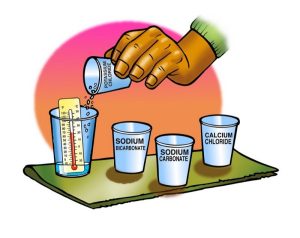
Procedure
- Label the small plastic cups Potassium Chloride, Calcium chloride, Sodium carbonate, and Sodium bicarbonate.
- Weigh 2 g of each solute and place them in their labeled cups.
- Add 10 mL of water to the small unlabeled cup and place a thermometer in the water. Record this initial temperature in the chart on the activity sheet.
- Pour the potassium chloride into the water and swirl the cup. Watch the thermometer.
- When the temperature stops changing, record the final temperature.
- Repeat steps 3–5 for each solute.
Expected Results
Potassium chloride dissolved the most endothermically, and calcium chloride dissolved the most exothermically. Student temperature readings will vary, but will likely be similar to the following:
| Solute dissolved in room temperature water (22 °C) | Maximum or minimum temperature achieved | Endothermic or exothermic? |
| potassium chloride | 14 °C | endothermic |
| calcium chloride | 45 °C | exothermic |
| sodium chloride | 32 °C | exothermic |
| sodium bicarbonate | 18 °C | endothermic |
Step 6
Discuss student observations.
Ask students:
- Which solutes dissolved endothermically?
Potassium chloride and sodium bicarbonate - Which solute dissolved the most endothermically?
Potassium chloride - Which solutes dissolved exothermically?
Calcium chloride and sodium carbonate - Which solute dissolved the most exothermically?
Calcium chloride
4 Explain
Step 7
Show students an animation of dissolving and explain that the energy of making and breaking “bonds” during dissolving causes a change in temperature.
Project the animation Breaking and Making Bonds.
Tell students that there is an important rule in chemistry: Energy is required to pull apart atoms, ions, or molecules that are attracted to each other. But when atoms, ions, or molecules come together, energy is released. One way to say it is, “It takes energy to break bonds, and energy is released when bonds are formed.”
Project the animation Energy and Dissolving.
Press the “next” button and explain that this happens in dissolving. When water molecules are attracted to and bond to the molecules or ions of a substance, some energy is released as shown by the arrow going out. Then the water molecules pull ions or molecules of the substance apart, which takes energy, as shown by the arrow going in.
Project the image Exothermic Dissolving.
The process of dissolving is exothermic when more energy is released when water molecules “bond” to the solute than is used to pull the solute apart. Because more energy is released than is used, the molecules of the solution move faster, making the temperature increase.
Project the image Endothermic Dissolving.
The process of dissolving is endothermic when less energy is released when water molecules “bond” to the solute than is used to pull the solute apart. Because less energy is released than is used, the molecules of the solution move more slowly, making the temperature decrease.
5 Extend
Step 8
Explore whether the process of crystallization can cause a change in temperature.
Project the video Hand Warmer.
In the hand warmer, the water molecules and the ions of the solute come together to form a crystal. Bending the metal disk creates tiny scratches, which act as nucleation points where the sodium acetate crystal forms. As the water molecules and ions bond together in the growing crystal, energy is released. This results in an increase in temperature.
Step 9
Liquids dissolving in a liquid can also cause a temperature change.
Project the video Temperature Change Alcohol in Water.
Explain that the “bonding” of water molecules to alcohol molecules releases more energy than it takes to separate the alcohol molecules from each other. This results in an increase in temperature.
What is the 5-E format?
The 5-E instructional model is an approach to teaching and learning that focuses on active engagement, inquiry-based learning, and collaboration.
Downloads
For Students
- Lesson 5.9 Student Activity Sheet PDF | DOCX | Google Doc
For Teachers
- Lesson 5.9 Lesson Plan PDF | DOCX | Google Doc
- Lesson 5.9 Activity Sheet Answers PDF | DOCX | Google Doc
- Lesson 5.9 Teacher Background PDF
Resources for the entire Chapter 5
- Chapter 5 Student Reading PDF | DOCX | Google Doc
- Chapter 5 Test Bank PDF | DOCX | Google Doc
Interactive Lesson Modules
- Lesson 5.9 Online Assignments Google Form
Have Questions? Visit Help Center
